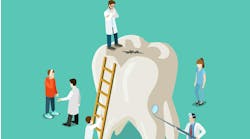By Jim Philhower
With insurance reimbursement falling and overhead rising, the average dentist has had difficulty being as profitable in the past five years. In fact, the average dentist's income has fallen more than 5%. Far too many dental practices spend an inordinate amount of time and productivity trying to increase profitability by reducing expenses. If you could reduce overall variable costs by 10%, the net effect would be a less than 1% reduction in overhead and an increase in your net monthly cash flow of a few hundred dollars. But focusing on a few small changes to increase production can have a big impact on cash flow and profitability. In fact, once fixed costs are covered, every dollar of increased production and collections will net $.80- $.85. Let's examine four areas to increase your production by $100,000 in 2014.
1. Maximize Hygiene Visits for Both Preventative and Therapeutic Patients
Recare and periodontal appointments usually represent the largest potential for practice growth. The average solo GP practice will have between 1,500 to 1,750 active patients. If we agree those patients should come in at least twice per year for preventive care, we would see between 3,000 to 3,500 hygiene appointments at a minimum annually. Yet we rarely see more than 2,000 total hygiene appointments in a practice. This includes prophies, scaling and root planing, and periodontal therapy procedures. Multiply the missing appointments by your average prophy fee and the lost production is substantial. Then add in the loss of doctor production since 75% to 80% of the dentist's restorative work typically comes from the hygiene department. Couple that with the fact that the office did not record a periodic exam or necessary radiographs on a visit that did not happen and the lost production number grows exponentially.
2. Balance Fees
Every year we still see dentists leave tens of thousands of dollars on the table by not having their fees balanced to a given percentile. While the increase in PPO participation over the past few years has limited the amount of increase the average office may realize by balancing its fees in a higher percentile, we still see many offices submit fees below what insurance companies are willing to reimburse. By balancing your fees in a fair percentile and submitting those full fees to the insurance companies, you can capture the full amount of coverage purchased and allowed for the patient by his or her employer, along with any increases in coverage. Balancing fees should be done at least every two years to help ensure maximum profitability.
3. Review Radiography Protocols
How often do you want your patients to receive X-rays? For bitewings, we almost always hear once a year. What about major films? Is it three years for a panoramic and five years for a full mouth series? If so, why? Once you have established a standard of care for radiography, it is much easier to articulate it to your team and patients. It's simple, but it is one of the biggest reasons that offices do not take radiography to the doctor's standard of care. Most dentists will agree that every new patient should receive a major film, yet rarely do the panoramic and full mouth series X-rays add up to the number of new patients seen in a given year – even when we factor in the new patients who brought a film with them. It adds up. Just one large film missed per day can equate to $25,000 annually. Without a protocol and focus, radiography can easily slip through the cracks.
4. Implement a Morning Huddle
If someone were to ask me what is the best and least expensive way to increase productivity, profitability, and reduce stress in your practice, I would say, "Have a successful morning huddle." Your morning huddle sets the tone and pace for the day, and is the best way to keep a team focused on patient care and production goals. The morning huddle agenda should consist of yesterday, today, and tomorrow. Yesterday, were all the patients called who required follow-up? Do we need to thank patients for referrals? Today, are we booked to goal? Where is the opportunity in the schedule for same-day dentistry? Who needs a radiograph? Which patients are seeing the doctor but are not current in hygiene? Tomorrow, what does the schedule look like for the doctor and hygiene team? Are we scheduled to goal? Are all the lab cases in? Once you get your morning huddle systems in place, the actual huddle should not take more than 15 minutes. The morning huddle is not a place for gripe sessions, new equipment purchase requests, or patient protocol changes. Save big-picture discussions for weekly team meetings.
For help implementing these strategies, visit www.HenryScheinBusinessSolutions.com and request a Henry Schein Practice Analysis.
Jim Philhower, a 28-year veteran of the dental industry, is the director of North America Dental Sales Leadership and Development for Henry Schein Dental. He teaches dental teams throughout the world techniques to help reach their practice goals. Contact him at (800) 372-4346 or send an email to [email protected].
Past DE Issues





